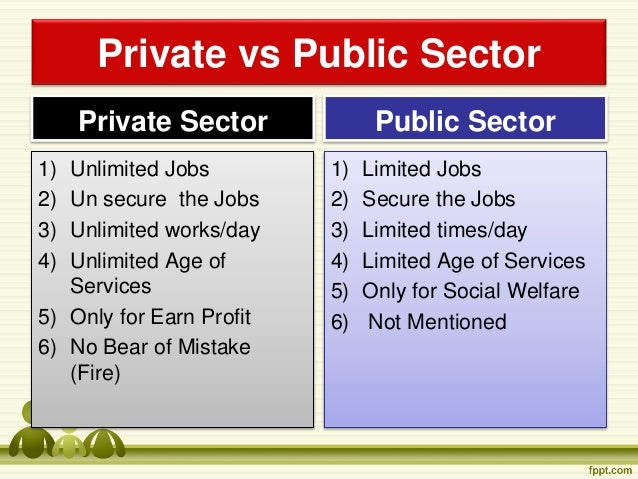 (image source : google.es)
(image source : google.es)
Concept or Definition
The public sector refers to the state apparatus, and the provision of public goods and services required. Funding for its operation comes entirely from taxing the public. The private sector consists of corporations and small businesses that also supply the public with goods and services, although operating funds come from private companies voluntary customer purchases.
Here is video shared below explaining about public and private sectors:
(video source : youtube.com)
Private sector :
In economics, the private sector is opposed to the public sector, is that part of the economy that seeks profit in their business and that is not controlled by the state. By contrast, companies that belong to the state are part of the public sector. Private nonprofit organizations are included as part of the voluntary sector.

(image source : google.es)
When we say that the private company is the engine of this sector, we must keep in mind that no matter what the volume or the legal form it has.
A company can be formed by an individual independently or legally thousands of workers and have various organizational options (limited partnership, corporation, partnership, a joint venture or UTE ...).
In any case, the main objective of the private sector is profit through products or services intended to be traded in a market in which it competes with other companies. The economic benefit is the fundamental aspect of the private sector, but not alone. Keep in mind that different companies create jobs in different economic sectors and employment has an obvious social and not purely economic dimension.
Another important issue in the private sector is its social responsibility. In recent years some companies have incorporated criteria that are not purely economic to direct their activities. You could say that certain values and ethics can be part of entrepreneurship. This reality receive a denomination, Corporate Social Responsibility (CSR). The key feature of these companies is that their social dimension (for example, commitment to the environment) is voluntary.
Legal Structure
The legal form in which they can develop the private sector is very diverse and ranges from individual exercise by a person with a business, to the use of a variety of legal forms depending on the each country.

The role of the private sector in economic activity :
The private sector is allowed to build and develop any type of activity except some public sector. The private sector is expected to diversify industrial production and make large investments, its role is also to attract investment and technology from abroad. Their role is also to contribute to development, job creation and sustainable medium-environmental management.
But it can also form small companies, both can be like a peddler or a small business by working there for themselves alone and on their own. All proceeds are personal and for profit.

(image source : google.com)
Public sector :
The public sector is the set of administrative agencies by which the state plays, or enforce the policy or will expressed in the laws of the country.
![]()
(image source : google.es)
This classification includes within the public sector: the legislature, executive, judiciary and autonomous public bodies, institutions, companies and individuals engaged in an economic activity on behalf of the State and who are represented by the same, ie power, covering all activities that the State (local and central government) own or control.
The public sector's role in the world :
The state institutions are different powers and government officials of the executive. The role and size of the public sector depend largely on what each moment is considered public interest; This requires defining in advance the scope of that general interest. Typically, the public sector constitutes a large percentage of a country's economy and influence on the overall socio-economic activity.
For example, the government may limit the growth of wages of officials to prevent increases in inflation, thus making a pricing policy and unofficial or informal incomes. The public sector is made up of the executive, legislature and judiciary and in the service of each and every citizen.
The public sector is composed of the national institutions that are all directed from the central government for the whole country, and the territorial or regional level are located in the province, state or province, county, city or town. For example, the executive branch of the national level is led by the Head of State, President or Prime Minister, who is in charge of all administrative policies of the nation, and the commitment to enforce the legal system for which it makes use of all ministries and institutions under their jurisdiction. However, in the territorial level governors and mayors are leading the regional policies of the areas they belong. Legislative power is in the national parliament consists of the Senate in many countries also by the House of Representatives or regions. Their mission is to study and uttering laws, which should be subject to the Constitution.

(image source : google.es)
The judiciary consists of the Supreme Court, in some countries by other High Courts and Constitutional or State, and all courts in the country. Its mission is to qualify compliance with all laws and punish or penalize non-compliance to all residents and natural persons (individuals) or legal entities (companies).
In addition to the three branches of the public sector make independent autonomous institutions that normally control the function of these officials. In many countries, among them the comptrollers, Public Ministry (Attorney, Ombudsman), Office and electoral authorities. In some countries might Attorney and the prosecutor are merged.
One of the characteristics of public servants is that they are paid with tax and other taxes or levies is that they can only perform the tasks that are specifically responsible for their work.
Relationship between the two sectors :
The private sector is also integrated in the public sector activity, through the granting and outsourcing services to the private sector. The movement from one activity from the public to the private is called privatization. The process by which firms are integrated in the public sector from the private sector is called nationalization.
The terms public and private sector are used to describe the main types of businesses and industries that exist in a given economy. Although it may offer similar services in both, the differences are still numerous major property and the target. The most obvious distinction between the two is that companies or public sector services are operated by the government and is publicly owned property, ie the state. For its part, the private sector is dominated by private individuals or legal entities.
Who is in charge?
One of the easiest ways to see the difference between an organization of private sector and public sector is to see who is in charge. In an organization of public sector employees, supervisors and managers are all state workers. The organization or company is not owned by a corporation or a private owner, but is owned by the state or regional government. Organizations and private sector companies, however, are privately owned and can answer to a board of directors, proprietary company or a sole proprietorship. The private sector employees work for the organization.
What is the main objective?
Besides the difference in the property, the two types of companies have a clearly different primary goal. The public sector groups have a duty to serve the citizen and, generally, are not in direct competition with other private or public groups for market share. Public sector organizations are not geared to profit. Although there are public companies that can offer real, it is common to offer services. In contrast, private companies are governed by objective economic benefit and compete to outdo other companies offering similar goods and services. Although some private companies may have humanitarian objectives, its main goal is profitability without necessarily having to serve the citizens.
What kind of jobs they offer is explained in the video shared below.
(video source : youtube.com)
What do they do?
The variety of businesses within the private sector is very extensive. We can find international corporations, retail stores, restaurants, hotels, malls, private television stations, publishers, schools and private universities, and some others. The nonprofit organizations also considered the private sector, unless they are supported by public money.
Businesses and public sector organizations tend to focus on services, mainly social, regulated in laws and decrees of the government agencies, whether national or regional. Among the most common services we can find public-schools, universities, police, fire and health services. Public transport systems, road maintenance or military are also often in the public sector.
Often the public sector and the private sector overlap offering citizens a choice between the services offered by public agencies or paying for private services that can better accommodate their needs. In the security industry usually choose private security services to monitor, for example, banks, shops or homes themselves; in these cases it may be possible to use public resources for the police and other security forces can not put their efforts in the home of a citizen or company can focus exclusively and protect private interests.

(image source : google.es)
Differences between Countries.
In each country we can find different policies regarding services offered by the public and private sector. Thus, we can find countries where the public sector is enormous and covers a variety of services, from education and health to energy and telecommunications. This variety of public services are usually held by high taxes.
Countries with a large private sector can offer the choice between different providers and, given the competition, paying less for a service with the same features. But there is one major drawback is that access is not guaranteed to low-income citizens, goods and services are subject to the whims of the financial markets.
Historical evolution :
In the period of the post-World War II global economy, governments in many countries encouraged the involvement of the public sector to the detriment of the private sector. In communist countries there were strong area nationalization process and virtually all economic activity occurred developed through the public sector.
Since 1980 the weight of the public sector in economic activity has been declining in favor of the private sector, including a series of privatizations that has lasted during the nineties and the early years of the century. Currently even countries that maintain socialist regimes such as China (market communism) and Vietnam, have a more or less important in the private sector in the production weight.
Thanks for reading, you can also read my other blog posts HERE, leave your comments below thanks, take care and goodbye!!!
~toshi-warraich~



